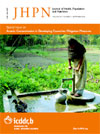
|
The Journal of Health, Population and Nutrition
icddr,b
ISSN: 1606-0997
EISSN: 1606-0997
Vol. 27, No. 2, 2009, pp. 139-155
|
 Bioline Code: hn09016
Bioline Code: hn09016
Full paper language: English
Document type: Research Article
Document available free of charge
|
|
|
The Journal of Health, Population and Nutrition, Vol. 27, No. 2, 2009, pp. 139-155
| en |
Quality of Obstetric Care in Public-sector Facilities and Constraints to Implementing Emergency Obstetric Care Services: Evidence from High- and Low-performing Districts of Bangladesh
Anwar, Iqbal; Kalim, Nahid & Koblinsky, Marge
Abstract
This study explored the quality of obstetric care in public-sector facilities and the constraints to programming comprehensive essential obstetric care (EOC) services in rural areas of Khulna and Sylhet divisions, relatively high- and low-performing areas of Bangladesh respectively. Quality was explored by physically inspecting all public-sector EOC facilities and the constraints through in-depth interviews with public-sector programme managers and service providers. Distribution of the functional EOC facilities satisfied the United Nation's minimum criteria of at least one comprehensive EOC and four basic EOC facilities for every 500,000 people in Khulna but not in Sylhet region. Human-resource constraints were the major barrier for maternal health. Sanctioned posts for nurses were inadequate in rural areas of both the divisions; however, deployment and retention of trained human resources were more problematic in rural areas of Sylhet. Other problems also plagued care, including unavailability of blood in rural settings and lack of use of evidence-based techniques. The overall quality of care was better in the EOC facilities of Khulna division than in Sylhet. 'Context' of care was also different in these two areas: the population in Sylhet is less literate, more conservative, and faces more geographical and sociocultural barriers in accessing services. As a consequence of both care delivered and the context, more normal vaginal and caesarian-section deliveries were carried out in the public-sector EOC facilities in the Khulna region, with the exception of the medical college hospitals. To improve maternal healthcare, there is a need for a human-resource plan that increases the number of posts in rural areas and ensures availability. All categories of maternal healthcare providers also need training on evidence-based techniques. While the centralized push system of management has its strengths, special strategies for improving
the response in the low-performing areas is urgently warranted.
Keywords
Emergency obstetric care; Health facilities; Health services; Maternal health; Maternal health services; Obstetric care; Quality of care; Rural health services; Bangladesh
|
| |
© Copyright 2009 - International Centre For Diarrhoeal Disease Research, Bangladesh
Alternative site location: http://www.jhpn.net
|
|
